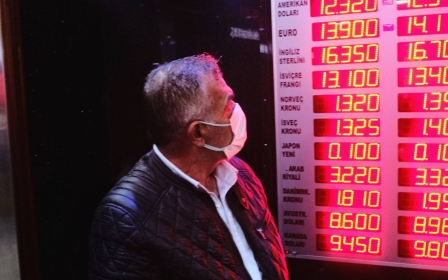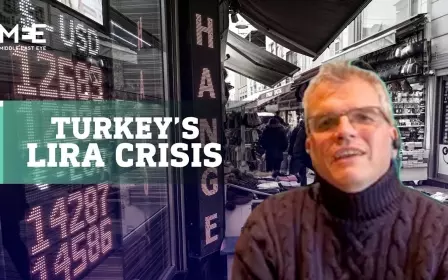Turkish dollar? Erdogan's new financial investment tool explained

Turkish President Recep Tayyip Erdogan’s unveiling of a new lira investment instrument that is denominated to foreign exchange rates upended the markets on Tuesday and depreciated the US dollar more than 29 percent against Turkey's currency in a single day.
What happened?
Erdogan has long insisted Turkey should have lower interest rates, and in August the Central Bank began to enact that with a series of cuts over the past few months. After repeated cuts, the real interest rate dropped below inflation to 14 percent, encouraging Turkish investors to flee the lira to foreign exchange (forex/FX) markets.
Erdogan, with his new Turkish lira investment tool, appears to have put a stop to this panic last night. At least for now.
The new tool, labelled the “Turkish dollar” by some on social media, offers a solution to this problem: if investors convert their foreign currencies into lira and deposit them in a savings account with a certain term of maturity, Turkey's treasury guarantees that it will get the same return as forex markets. And if the forex markets drop below the official interest rates, the investor will still get an official interest rate return.
Turkish Finance Minister Nureddin Nebati said in a written statement that the new instrument will have three, six, nine and 12 month maturity term options, and investors who withdraw their money from the saving accounts before the fixed term completion will only receive their savings denominated to lower a forex rate as punishment.
The tool has basically removed the need for Turkish investors to keep their money in foreign exchange deposits and sparked a huge drive to buy lira. According to the Union of Turkish Banks, more than $1bn has been already sold through the banks as Erdogan spoke, even though the markets were closed.
However, economists widely criticised the move as it would increase the public debt, with the treasury paying any difference between the foreign exchange rate and lira.
“In effect, all this just increases dollarisation, as the deposit base either is in FX or now FX linked,” Tim Ash, a senior strategist at London-based BlueBay Asset Management, said. “And the public purse picks up the bill. Arguably dollarisation shifts from the private to public sector.”
Many Turkish economists, on the other hand, argued that the new tool is a veiled interest rate hike, because the treasury will in effect pay the difference with inflation as well.
“They made an epic interest rate hike without calling it a hike,” Refet Gurkaynak, a renowned economics professor, tweeted.
Mahfi Egilmez, another well-known Turkish economist, said: “If foreign exchange rate is up 40 percent and the interest rate is 14 percent, [the treasury] will pay the 26 percent in between. And this won’t be called an interest rate. Incredible.”
There are also concerns that the new tool will even push inflation to higher levels as it requires more lira to be injected into the markets.
An old scheme?
The tool itself reminded experts of something that was tried by Turkey in the 1970s to attract foreign currency flows, mainly from the Turkish citizens living abroad. "Convertible Turkish lira deposits” (CTLDs), as it was known at the time, guaranteed the principal and interest payments on these deposits against all risk created from devaluations of the currency.
The scheme eventually led to a huge credit explosion by local banks and triggered a new wave of inflation. It also had an excruciating burden on the treasury, which eventually ended the scheme in 1978 and carried $2.5bn debt.
Baris Soydan, a prominent Turkish journalist, said in a column on Tuesday that the idea was initially brought back by officials in 2018, but they quickly abandoned it because of possible and deep ramifications on the treasury.
Lutfi Elvan, Turkey's recently resigned finance minister, also opposed the idea this year after the lira meltdown began, according to Soydan’s sources.
“He said that the Turkish government finances would receive a sharp blow if this scheme gets out of control during a forex crisis,” he wrote. “And the crisis would deepen because it would jump the country risk premiums.”
Elvan also reportedly said that the scheme could also mean a wealth transfer to high-income segments of society, because they are more able to invest and get better returns than the rest.
In any case, the scheme’s current impact on the foreign exchange rate triggered a wave of celebration among government circles. Erdogan’s communications director Fahrettin Altun said the developments show that the president again kept his promise and delivered.
Ruling AK Party spokesperson Omer Celik shared a series of photos on Twitter where Erdogan appears to be taking the Turkish flag from the ground. “Turkey wins,” he said.
Government-aligned Sabah newspaper said in the main headline on their website that Erdogan’s announcement broke the back of the dollarisation.
Pro-government Yeni Safak newspaper featured an interview with a citizen who sold his US dollar savings during a visit to a foreign exchange office on Tuesday. “I’m happy that the US dollar is down," he said. "Even though I turned a loss.”
Middle East Eye propose une couverture et une analyse indépendantes et incomparables du Moyen-Orient, de l’Afrique du Nord et d’autres régions du monde. Pour en savoir plus sur la reprise de ce contenu et les frais qui s’appliquent, veuillez remplir ce formulaire [en anglais]. Pour en savoir plus sur MEE, cliquez ici [en anglais].





